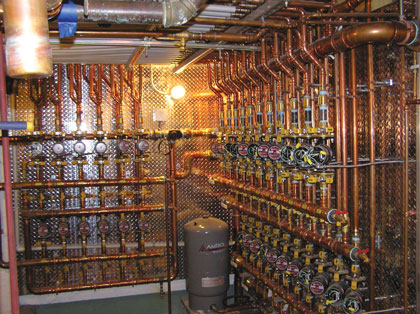From the outside, the 1920s villa in the seaside community of Newport, Rhode Island, appears as any other stately historic home in the neighborhood. But inside the 15,000-square-foot house, the heating system is state-of-the-art—complete with Wi-Fi and remote programming capabilities—powered by a Bell & Gossett (B&G) pump system.

The 15,000-square-foot historic home requires a heating system that is both dependable and efficient.
UPDATING THE PAST
The old cast-iron steam boiler was obsolete and expensive to run, costing the homeowners $20,000 a year in oil alone. Property caretaker Jeff Ward started investigating options to convert the system from steam to hot water, downloading manufacturers’ manuals to compare and contrast pumps for the system. He set up a beta test in the house to find the most effective and energy-efficient model by measuring output through an amp meter.
B&G’s ecocirc vario circulator pump met Ward’s criteria, most notably because of its electronically commutated permanent magnet motor designed specifically for hydronic systems. In Ward’s test, the ecocirc heated the room while operating at just ¼ of an amp and maintained consistent pressure.

The ecocirc® vario allows for step-less speed control to set the pump performance to meet individual system requirements.
ECOCIRC: A CLOSER LOOK
Compared to its competitors in the field, the ecocirc has numerous advantages. First, it uses less wattage at maximum speed — 60 watts versus 85 watts — resulting in roughly a 30 percent savings in energy. In addition, its variable speed capabilities allow it to adjust to demand instead of running at maximum speed at all times, resulting in less energy use.
While proper pressure within the system was a primary consideration, the ecocirc also proved it could handle the long heat runs in the 20-room house for just pennies a day in electricity costs, another priority for Ward.

The ecocirc® vario circulators were designed with highly efficient electronically commutated permanent magnet motor (ECM/PM technology) specifically for hydronic systems.
MIXING OLD AND NEW
Steve Graham of local B&G representative Fluid Industrial Associates Inc. (FIA), helped marry the new circulator technology with the home’s existing radiators — sixty-seven in all. “It was a challenge to reuse the radiators and run new piping without it becoming a major construction project,” said FIA Vice President George Carey. “But aesthetically the radiators fit the look of the house and the homeowners wanted to keep them.”
The process of disassembling and cleaning all of the radiators took two years. Crews had to work around some of the complicated plumbing features of the house, such as two of the radiators being located behind built-in bookcases. Specialized tubing connects the radiators and the 25 ecocirc pumps, now in a centralized location in the house, to the new modulating gas boiler.

With the radiator adapted to new system, the historic home’s heating will be more effective and efficient.
A THOROUGH JOB
The ancient boiler was only part of the home’s heating problem. Previously, there were only two zones to control the temperature in the house. Installed by Steve Antoch of A&L Plumbing and Heating, the new system features thirty-four zones, and has Wi-Fi capability. Now, while the homeowners are out, they can send a text to Ward, who can program the system remotely so they arrive to comfortable temperatures inside the house.
Another key feature of the system is its outdoor reset, which takes into account the outdoor temperature when heating the water. For example, water is heated to 180 degrees Fahrenheit (82.2 degrees Celsius) on a 10-degree Fahrenheit (-12.2 degrees Celsius) day but only needs to be heated to 110 degrees Fahrenheit (43.3 degrees Celsius) on a 50-degree Fahrenheit (10 degrees Celsius) day.
RESULTS YOU CAN SEE
The new system is already paying dividends, with fuel costs plunging about 80 percent in just a few months. “This is the fastest payoff ever,” Ward said. “We don’t need oil anymore.”
Contrast that with the carriage house on the property, which is still fueled by an outdated system, costing about four times as much to heat than the main house now does. ■
About The Author
Mark Handzel is the vice president of product regulatory affairs and director of HVAC commercial buildings for Bell & Gossett, a Xylem brand. Bell & Gossett is the world leader in energy efficient pumps. For more information, visit www.bellgossett.com.
MODERN PUMPING TODAY, March 2015
Did you enjoy this article?
Subscribe to the FREE Digital Edition of Modern Pumping Today Magazine!


